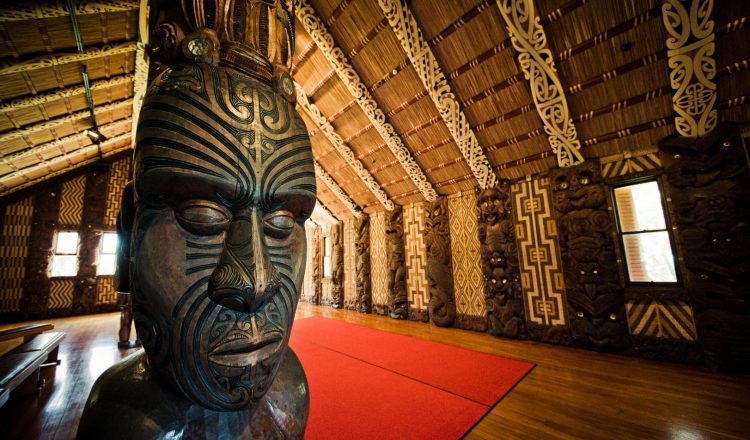Phong trào Maori King
Những người đầu tiên đến bờ biển New Zealand là tổ tiên của người Maori, ở đâu đó từ năm 1200 đến năm 1300 sau Công nguyên. Những người đi biển lành nghề này đã sử dụng gió, các vì sao và dòng chảy để di chuyển theo cách của họ từ Polynesia và bắt đầu lan rộng ảnh hưởng của họ xung quanh hòn đảo. Người Maori tự chia mình thành các nhóm, được biết đến trong ngôn ngữ của họ là iwi. Iwi có thể dịch sang một quốc gia hoặc dân tộc, và những iwi này thường rất lớn và có nhiều tiểu bộ lạc bên trong họ được gọi là hapu. Hapu là đơn vị chính trong cơ cấu xã hội Maori và thường chứa khoảng 500 người, được tạo thành từ nhiều gia đình mở rộng. Mỗi hapu độc lập với hapu khác trong iwi và thường sẽ được phân chia khu định cư cho các gia đình.
Theo một cuộc điều tra dân số gần đây, iwi lớn nhất ở New Zealand là:
- Ngapuhi (125,601)
- Ngati Porou (71,049)
- Ngãi Tahu (54.819)
- Waikato (40.083)
Các vị vua Maori
Đứng đầu hệ thống phân cấp xã hội của người Maori là thủ lĩnh. Mỗi bộ lạc có một tù trưởng sẽ lắng nghe mối quan tâm của người dân và tập hợp họ trong lúc khó khăn. Mặc dù định cư các vùng đất, các bộ lạc không có khái niệm về quyền sở hữu đất đai. Vùng đất chỉ có được bằng cách chinh phục và chỉ thực sự thuộc về một iwi nếu họ tích cực sử dụng nó. Điều này đã trở thành một vấn đề lớn sau khi nhiều người định cư châu Âu đến, mong muốn mua mảnh đất của họ và thành lập các thị trấn và cộng đồng.
Phản ứng của người Maori đối với việc chiếm đất của châu Âu là trái chiều, một số iwi bán đất của họ, trong khi những người khác phản đối việc xâm nhập. Với việc người Anh sáp nhập New Zealand và đe dọa can thiệp quân sự, các thủ lĩnh người Maori buộc phải hành động để cố gắng bảo vệ quê hương của họ. Họ nhận ra rằng họ không thể chống lại sự tiến bộ của châu Âu khi bị chia rẽ; thay vào đó, các thủ lĩnh Maori nhìn vào thứ mà họ cho là sức mạnh của phe đối lập; một chế độ quân chủ mạnh mẽ.
Năm 1858, người Maori chọn thủ lĩnh của Waikato iwi làm vua của họ; Potatua Te Wherowhero. Tuy nhiên, ông mất sớm sau khi trị vì và con trai của ông là Tawhiao kế thừa tước vị và cuộc đấu tranh chống lại người Anh. Bất mãn và lo ngại trước sự thống nhất của người Maori, chính phủ lãnh đạo của Anh đã xâm lược vùng đất Waikato vào năm 1863 và bắt đầu Chiến tranh Waikato kết thúc bằng việc người Anh đầu hàng nhiều vùng đất hơn.
Trong vòng 100 năm tiếp theo, các vị vua Maori kế vị sẽ cố gắng giành lại những vùng đất đã mất của họ trên chiến trường chính trị, giữ mối quan hệ chặt chẽ với London và Hoàng gia Anh. Họ đã không thành công cho đến năm 1975 khi nữ hoàng Maori đầu tiên, Nữ hoàng Te Atairangikaahu đứng ra dàn xếp với chính phủ, một bước tiến lớn đối với cách tiếp cận tiến bộ đối với văn hóa Maori mà chúng ta thấy ngày nay. Bà là quốc vương Maori tại vị lâu nhất, lãnh đạo dân tộc của mình trong 40 năm cho đến năm 2006 khi con trai bà, Tuheitia lên kế vị. Vua Maori tiếp tục cung cấp một hình tượng văn hóa cho người Maori thống nhất và có một vai trò nghi lễ quan trọng.

















































